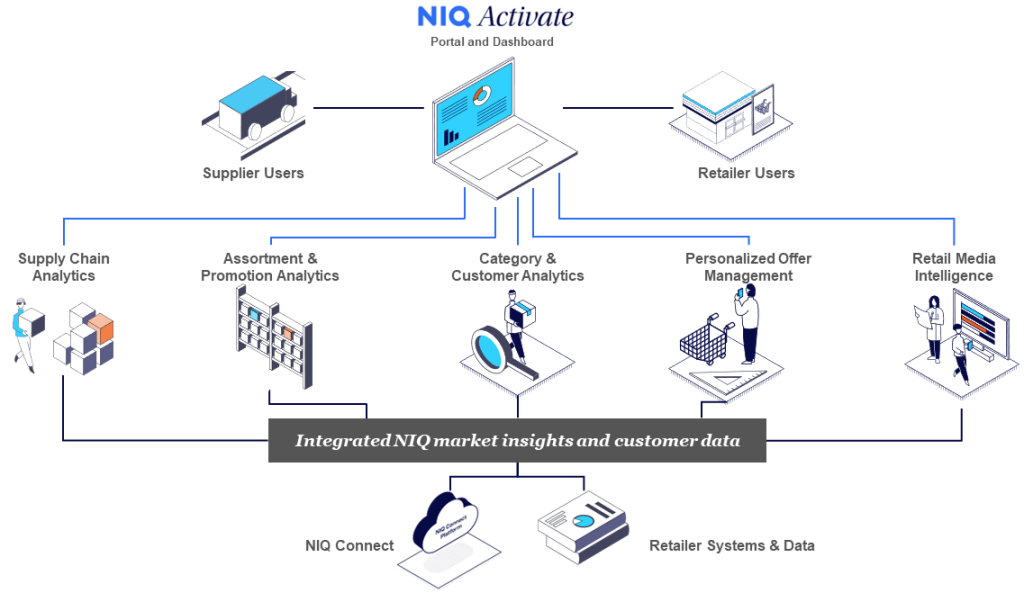Divided we fall: The separation of supplier collaboration
Collaboration is on the minds of today’s retailers, who are serious about working with brands to capture value from their first-party data and using it to boost their bottom line.
Historical efforts to share information with brands were led by their merchandising or marketing functions, often designated as a side project for a few insiders. As they came to better understand the demand for shopper data, retailers built specialized teams to solely focus on these endeavors.
With the rise of Chief Revenue Officer roles and trademarked media networks, it is now common to see entire business units dedicated to data monetization and supplier collaboration.
There is reason to be cautious of this trend. The pursuit of alternative revenue streams, and growing pressure from Wall Street, can drive a wedge between new revenue programs and the core retail mission.
Fortunately for brands, retailers, and consumers, there is a clear path forward that delivers value to all parties.
What’s behind the collaboration push?
Retailers watched as brands heavily invested in major digital platforms, like Amazon and Google, for paid ads and shopper insights. Now, as they face an inflationary market and other cost pressures, they’re determined to get their fair share.
Manufacturers are also eager to take advantage of these new opportunities. Retailers can deliver large, relevant audiences to brands through targeted media placements at key purchase decision milestones. Suppliers can then see the direct return on their investments with retailers’ first party insights, tracked across websites, loyalty apps, and point of sale logs. Such data access also comes with a fee, a reminder that retailer-supplier collaboration must be a mutually beneficial relationship.
Why compartmentalize monetization from merchandising?
It is understandable why retailers have disconnected their alternative revenue businesses from merchandising. While merchandising teams sit at the receiving end of delicate brand negotiations, monetization teams are focused on capturing pre-set revenue targets with quick sales cycles. Most retailers have chosen not to burden merchants with new responsibilities that could complicate their already-complicated buying process.
An executive we spoke with at a large chain described their organization’s intent to “keep it pure,” meaning they want to make certain that brands’ buying decisions have validity on their own — without the confounding influence of merchandising negotiations. In the beginning days of retail media, annual planning meetings could be tangled in discussions of allowances and program designs to boost merchandise volumes. Today, retailers must eliminate any perception that retail media is a “cost of doing business” and not a legitimate growth opportunity for brands.
The dangers of a disconnected retail team
While retailers have a good argument for completely separating merchandising from monetization, restricting collaboration and connection poses a risk. These two groups are sometimes at odds, chasing competing objectives.
One retail executive observed that alternative revenue teams are typically incentivized to sign up as many suppliers and send as many offers as possible, without necessarily planning to reach the right shopper segments or support the overall merchant goals. These sales are not driven by the merchandising organization, but they still require closed-loop reporting. This is not an easy task.
An article published by Total Retail describes the challenge:
If retailers want to capture $150 million in retail media network revenue, they’re going to need a team in the mid double-digits to do campaign planning and sell the additional inventory, and to provide return on advertising spend (ROAS) and measure incrementality once it is sold.
Hilding Anderson, “How Retailers Can Capture the Full Potential of Retail Media Networks in 2023,” TotalRetail, January 24, 2023
The issue is the same for other forms of collaboration and monetization. Each retailer must manage data transfers, privacy laws, advanced analytics, marketing, sales, contracting, training, support desk, software development or work with a partner that aids in some/all of these areas.
Where the connections need to happen
The conundrum, of course, is that every program of this kind is intended to influence shopper take-away at the physical and digital shelf. This brings two interlocking consequences: an increase in demand and transfer of demand, raising several important questions:
- A retail media campaign by an endemic brand will naturally require coordination of sufficient inventory to support expected increase in demand. This planning step is routine in trade marketing, but can it be linked to the media buying process?
- In joint business planning or category strategy review meetings, data and insights are the foundation for big decisions. Which insights and data sets will serve as the single version of the truth? Will merchants be well-versed on the analytics and data sets that suppliers are paying to access?
- Promotions often cause transfer of demand among similar items. Partners must plan for inevitable interaction effects, such as cannibalization of alternative items and post-event fall-offs due to pantry-loading. What data science will help them anticipate and respond to these effects?
- Retailers typically activate multiple campaigns across their physical and digital assets, including display ads, messaging touchpoints, promotions, and other tactics designed to appeal to one or more of their customer segments. Does a particular paid advertisement complement or conflict with these other efforts?
Put simply, a retailer’s insights platform democratizes analytics and data science, so it becomes the truth used by merchants and retailer teams. It must be accepted, adopted, and embedded into the retailer’s category management and marketing processes. When this does not occur, suppliers may suspect the data isn’t worth the investment.

Collaborate with suppliers to go from data, to insights, to activation all in one platform
- Advanced, AI-based platform
- One version of the truth
- Mutual, profitable growth
Four ways to put collaboration into practice
If monetization is rightly siloed from merchandising, how will retailers overcome these challenges? Four key practices apply:
1
Align key metrics for customer focused growth.
Define and align on the right key performance indicators (KPIs). Retailers will want to integrate some of their customer KPIs into the scorecards of both merchant and alternative revenue teams. This will not only align actions to the correct incentives, but also promote internal adoption of these platforms as they become a mandatory tool to measure success. In this scenario suppliers need not feel they are being taxed, since their retail trading partners will be well versed on the key outcomes and metrics.
2
Partner early with merchandising and marketing.
Buy-in from merchandising and marketing leaders (including loyalty teams) will go a long way toward both retail sales growth and alternative revenue goals. They should be natural allies, but partners can be put in an adversarial mindset if they perceive that others are interfering with supplier relationships or cutting into trade dollars. Collaboration with respect to data and retail media should drive their business results if it is done in a customer centric way. Consider that there is no better advocate for selling a program or media partnership than a chief merchant. This should be a win/win.
3
Adopt a comprehensive, modern platform.
Alternative revenue programs are best implemented from a shopper-driven perspective. Technology and data science enable that consumer view. Some legacy platforms have not evolved much over the years. That means that they may not span all use cases (POS, supply chain, customer insights, assortment, promotion, personalization, retail media, etc.). To assure competitiveness and maximize adoption by partners and internal teams, deploy technology that is speedy, flexible, and intuitive, and powered by modern AI/ML science.
4
Share results transparently.
Delivery and measurement of results must be an integral part of the program and close the loop in the platform being used. Having documented case studies of how insights have driven mutual growth to more sophisticated uplift and ROAS metrics. Sharing these transparently is a key element to build trust.
Retailers should adopt these guidelines and consider how they can unlock joint value with their trading partners.

Pave your path to connected collaboration
NIQ provides a pathway for connected collaboration, defined by transparency and technical rigor. Set up a meeting to learn how our collaboration platform delivers a win-win-win for you, your suppliers, and your customers.

About the author
Petros Petropoulos, SVP, Retail, NIQ
Petros has over 15 years of experience working from within retailers and consulting for customer focused firms across industries. He has focused on helping his clients create customer driven strategies using data/insights and developing new business models around monetizing these data assets. Petros is currently a leader for NIQs Retail Strategy and developing their Connected Collaboration offerings.
He is a former Strategy consultant at firms including Deloitte and McKinsey & Company, he also has an MBA from the University of Chicago, Booth School of Business



